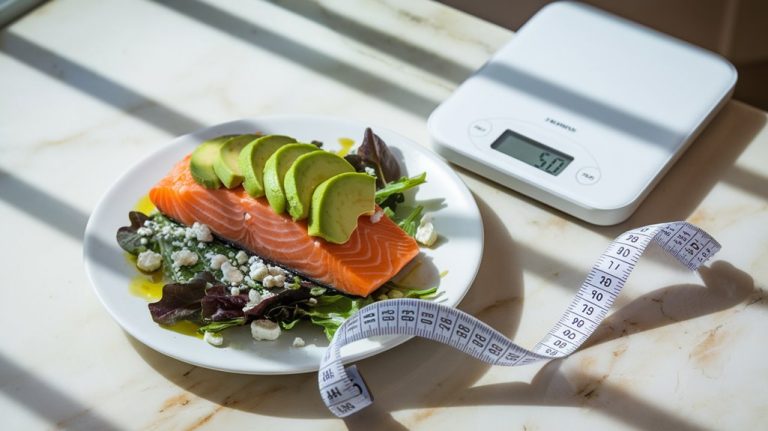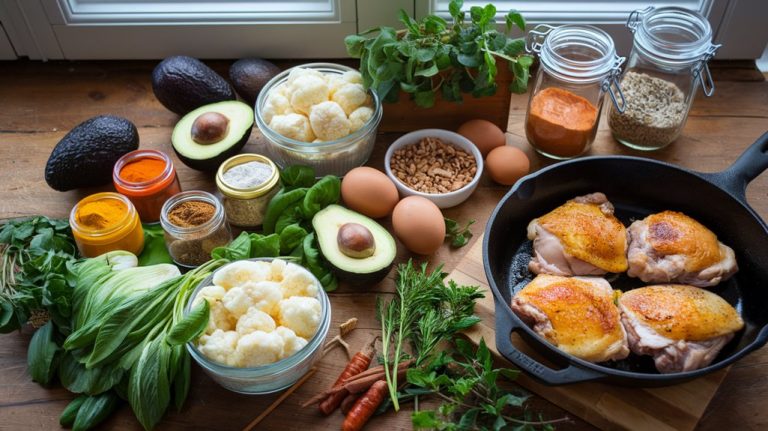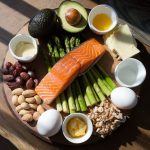You can satisfy your sweet cravings while maintaining ketosis by choosing low-carb fruits strategically. Focus on berries like raspberries (3g net carbs/half cup) and blackberries (4g net carbs/half cup), or tropical options like fresh coconut (2.2g net carbs/half cup). Track your portions carefully, and pair fruits with high-fat foods to slow sugar absorption. For best results, stick to fruits under 5g net carbs per serving and monitor your ketone levels. Understanding the complete fruit selection guide will enhance your keto journey.
Key Takeaways
- Focus on berries like raspberries and blackberries, which contain only 3-4g net carbs per half cup serving.
- Pair low-carb fruits with high-fat ingredients to slow sugar absorption and maintain ketosis.
- Transform fruits into keto-friendly desserts using sugar-free cream cheese and almond-based toppings.
- Monitor ketone levels regularly when introducing fruits to determine individual tolerance and adjust portions accordingly.
- Create keto-friendly fruit drinks and fat bombs using watermelon, raspberries, and coconut-based ingredients.
Understanding Net Carbs in Fruits

When following a low-carb diet, understanding net carbs is essential for making informed choices about fruit consumption. You’ll need to master the simple calculation of subtracting fiber content from total carbohydrates to determine net carbs in your foods. This calculation matters because fiber doesn’t impact your blood sugar or insulin levels, making it safe for ketogenic diets.
You’ll want to keep your daily net carbs between 30-50g to maintain ketosis effectively. When choosing fruits, focus on those with higher fiber content, as they’ll typically have lower net carbs. While you track your macros, remember that fiber’s undigestible nature means you can subtract it from your total carb count. This knowledge allows you to incorporate fruits strategically while staying within your keto dietary limits.
Best Berry Options for Keto Success
Berries stand out as the ideal fruit choice for your ketogenic lifestyle, offering the perfect balance of taste and low net carbs. Among your best options, raspberries contain just 3 grams of carbs per half cup, while blackberries follow closely with 4 grams. Strawberries remain keto-friendly at 6 grams per 100 grams.
You’ll want to limit or avoid blueberries, as they pack 9 grams of carbs per half cup and higher sugar content. Instead, focus on combining smaller portions of raspberries, blackberries, and strawberries for variety. To maximize your berry enjoyment while maintaining ketosis, stick to half-cup servings and pair them with full-fat yogurt or unsweetened whipped cream. Remember, tracking your portions carefully guarantees you’ll stay within your daily carb limits.
Tropical Fruits That Won’t Break Ketosis

Despite their reputation for being high in sugar, several tropical fruits can fit into a ketogenic diet when consumed mindfully. Fresh coconut leads the pack with just 2.2 grams of net carbs per 1⁄2 cup serving, followed closely by starfruit at 2.5 grams. While melons contain more carbs, you can still enjoy them in moderation. Watermelon and cantaloupe provide about 5.5-5.8 grams of net carbs per 1⁄2 cup serving, plus beneficial vitamins A and C.
To incorporate these fruits successfully, pair them with fats like feta cheese to slow sugar absorption. Focus on portion control, especially with melons, which contain 8-11 grams of carbs per 100 grams. You’ll get the most flexibility by choosing lower-carb options like starfruit and coconut while carefully portioning higher-carb selections.
Citrus Fruits and Their Keto Impact
When you’re counting carbs on keto, lemons and limes emerge as your citrus allies with only 2-3 grams of net carbs per fruit, while oranges and grapefruits require more careful portioning at 9-10 grams net carbs per serving. Beyond their carb counts, citrus fruits pack powerful health benefits through their vitamin C content, flavonoids, and other bioactive compounds that support immune function and reduce inflammation. You’ll find these fruits particularly valuable on keto not just for their nutritional benefits, but also for their ability to enhance the flavor of dishes without significant carb impact, especially when using their zest or small amounts of juice.
Lemon Lime Carb Counts
Understanding citrus fruits’ carbohydrate content is essential for maintaining ketosis. Lemons contain the lowest net carbs at 3g per 100g serving, making them your most keto-friendly citrus option. Limes have a higher carb count at 7.74g per 100g, while citrons contain 6.52g per 100g.
You’ll want to pay close attention to portion sizes. A medium lemon contains 3g of net carbs, while half a lime adds 2.3g to your daily intake. Citrons pack the highest carb punch, with a medium-sized fruit containing nearly 15g of net carbs when prepared. To stay in ketosis, you’ll need to carefully monitor these amounts since the typical keto diet restricts carbs to 20-50g daily. Consider using lemon as your primary citrus choice, as it provides essential nutrients while keeping carbs low.
Citrus Benefits Beyond Sugar
The nutritional value of citrus fruits extends far beyond their carbohydrate content. You’ll find essential nutrients like vitamin C, which promotes healthy skin and bolsters your immune system. Lemons and grapefruits are particularly beneficial on a keto diet, offering significant health advantages while maintaining relatively low net carb counts.
These fruits support your health in multiple ways: they may reduce kidney stone risk, enhance liver function, and aid weight loss efforts. You’ll get an impressive 30-40mg of vitamin C from just one lemon, while half a grapefruit provides 37mg. They’re also rich in potassium and fiber, making them valuable additions to your low-carb lifestyle. When consumed in moderation, citrus fruits won’t disrupt ketosis and can actually improve insulin sensitivity and metabolic health.
Managing Fruit Portions on a Low-Carb Diet

Successfully managing fruit portions on a low-carb diet requires precise measurements and careful planning. You’ll need to weigh or measure your fruits using proper tools to guarantee you’re staying within your daily carb limits. Understanding serving sizes is essential – one carb serving equals 15 grams of carbohydrates.
| Fruit Type | Serving Size | Net Carbs |
|---|---|---|
| Strawberries | 1 cup | 8g |
| Apple | 1 small (4 oz) | 15g |
| Raspberries | 1 cup | 5g |
| Watermelon | 1 cup | 11g |
| Banana | 1 small (4 oz) | 23g |
To maintain ketosis while enjoying fruits, limit your intake to 1-2 servings daily. Choose lower-carb options like berries, which provide maximum nutritional benefits with minimal carb impact. Remember that fruit juices aren’t recommended due to their concentrated sugar content and lack of fiber.
High-Sugar Fruits to Avoid
When following a low-carb diet, certain fruits can quickly derail your carbohydrate goals due to their high sugar content. You’ll want to avoid or strictly limit tropical fruits like mangoes, which contain 28g of sugar per whole fruit, and pineapples with 16g per cup. Jackfruit is particularly sugar-dense at 31g per cup.
Common fruits that you should monitor closely include bananas (14g per medium fruit), apples (19g per medium fruit), and grapes (23g per cup). Dried fruits are especially concentrated in sugar, with raisins containing a whopping 108g per cup. While fruits offer valuable nutrients, these high-sugar options can impact your ketosis. Instead, you’ll need to carefully portion these fruits or choose lower-sugar alternatives to maintain your low-carb lifestyle.
Seasonal Low-Carb Fruit Selections

You’ll find an abundance of low-carb berries during summer months, with raspberries containing just 4.6g of carbs per 100g and blackberries offering 5.1g per 100g serving. Winter brings citrus options like lemons with 3.2g of carbs per 100g, which can brighten up your low-carb meal plans year-round. For the best nutritional value and taste, choose fruits that are in season, keeping in mind that some options like avocados and coconuts maintain consistent carb levels throughout the year.
Summer Berry Selection Guide
Summer berries offer exceptional choices for low-carb dieters, with most varieties containing fewer than 7 grams of carbohydrates per 100-gram serving. Raspberries lead the pack with just 4.6g of carbs, followed by blackberries at 5.1g and strawberries at 6.1g per 100g serving. Blueberries and cranberries, while not specifically quantified, are also recognized as low-carb options.
You’ll maximize your berry benefits by implementing strategic portion control and pairing them with low-carb companions like nuts or sugar-free yogurt. This combination helps moderate blood sugar impact while providing essential nutrients. For ideal results, incorporate berries into your meals throughout the day – they’re particularly effective when added to breakfast bowls or as naturally sweet snacks between meals.
Winter Citrus Fruit Picks
While summer berries shine during warmer months, winter brings its own array of low-carb citrus fruits packed with flavor and nutrition. For your ketogenic lifestyle, select specific varieties that offer the best balance of carbs and nutrients. Lemons and limes are your lowest-carb options, while grapefruits contain moderate carb levels but offer substantial fiber content.
You’ll find Meyer lemons particularly valuable, as they provide a sweeter profile with less acidity than standard lemons, making them ideal for both cooking and flavoring water. When choosing oranges, opt for smaller portions of blood oranges, which deliver unique antioxidants and a lower glycemic impact compared to regular varieties. Remember to track your portions carefully, as even low-carb citrus fruits can impact your daily carb limits when consumed in larger quantities.
Creative Ways to Enjoy Keto-Friendly Fruits
Following a ketogenic diet doesn’t mean giving up the delicious flavors of fruit entirely, as there are numerous creative ways to incorporate low-carb fruits into your meal plan. You can transform berries into elegant desserts like keto fruit pizza with sugar-free cream cheese topping or berry crisps with buttery almond toppings. For quick snacks, try blackberry coconut fat bombs or invigorating caprese kebabs with strawberries. You’ll find satisfaction in keto-friendly drinks like watermelon mojitos and raspberry milkshakes, all made with appropriate low-carb sweeteners. To maintain ketosis while enjoying fruits, focus on portion control and select high-fiber options like berries and avocados. Balance your daily carb allowance by incorporating fruits strategically into your meals and desserts.
Nutritional Benefits of Low-Carb Fruits

Despite their lower carbohydrate content, low-carb fruits pack a powerful nutritional punch with essential vitamins, minerals, and bioactive compounds. You’ll find abundant antioxidants in berries, which improve biomarkers related to chronic diseases, while watermelon provides cancer-fighting lycopene. Avocados deliver heart-healthy monounsaturated fats and fiber, supporting both cardiovascular health and weight management.
Here are three standout nutritional powerhouses among low-carb fruits:
- Kiwi – Contains twice the vitamin C of oranges, helping regulate blood sugar and lower cholesterol
- Raspberries – Provides 8 grams of fiber per cup with only 7.5 grams of carbs per half-cup
- Cranberries – Offers anti-inflammatory properties and UTI protection while containing just 12 grams of carbs per cup
These fruits demonstrate that you can enjoy sweet flavors while maintaining ketosis and receiving significant nutritional benefits.
Fruits That Help Combat Sugar Cravings
When you’re following a low-carb diet but craving sweets, certain fruits can satisfy your sweet tooth while maintaining ketosis. You’ll find berries, particularly strawberries and raspberries, offer natural sweetness with minimal impact on blood sugar levels, while their high fiber content helps control cravings. Watermelon and muskmelon provide invigorating sweetness and hydration, making them effective alternatives to high-carb desserts when consumed in moderate portions.
Sweet Yet Keto-Safe Options
For those battling sugar cravings while maintaining ketosis, several low-carb fruits offer natural sweetness without derailing your diet. Berries emerge as your best allies, with blackberries, raspberries, and strawberries containing between 7-8.2 grams of net carbs while providing substantial fiber and antioxidants.
When you’re looking to satisfy your sweet tooth while staying keto-compliant, consider these proven options:
- Mix blackberries into your morning smoothie – they pack 5 grams of fiber and only 7 grams of net carbs
- Blend strawberries into keto ice cream – they’re rich in vitamin C with just 8.2 grams of net carbs
- Create raspberry fat bombs – these berries offer 4 grams of fiber and potent antioxidants while keeping carbs low
Natural Sugar Control Methods
Managing sugar cravings effectively requires strategic fruit selection that won’t spike your blood glucose levels. You’ll find success by choosing fruits with high fiber content and low glycemic loads, while maintaining portion control for ideal ketosis.
| Fruit Type | Blood Sugar Impact |
|---|---|
| Apples | Low GI, helps regulate blood sugar |
| Cherries | Rich in antioxidants, low GL |
| Apricots | High fiber, slows sugar absorption |
To maximize blood sugar control, you’ll want to pair your fruits with protein or healthy fats. For instance, combine apple slices with cheese or berries with nuts. Keep your daily carbohydrate intake between 20-50 grams to maintain ketosis while satisfying your sweet cravings. Remember, fresh whole fruits are superior to dried options, as they contain more fiber and water content that aids in sugar regulation.
Best Craving-Busting Berries
Among nature’s most effective tools for fighting sugar cravings, berries stand out as nutritional powerhouses that can help you stay on track with your low-carb lifestyle. Their natural sweetness, combined with high fiber content and antioxidants, helps regulate blood sugar while satisfying your sweet tooth.
When choosing berries for your low-carb diet, consider these top options:
- Strawberries lead the pack with just 7.7g net carbs per 100g serving, making them the most keto-friendly choice
- Blackberries offer impressive fiber content (8g per serving) and only 6g net carbs per cup
- Raspberries provide exceptional blood sugar control with their low glycemic index and high fiber content
You’ll find these berries versatile enough to incorporate into smoothies, yogurt, or low-carb baked goods while maintaining ketosis and supporting your health goals.
Incorporating Fruits Into Keto Meal Plans
Successfully incorporating fruits into a keto meal plan requires strategic choices and careful portion control to maintain ketosis while accessing essential nutrients. Start by selecting low-carb options like berries, avocados, tomatoes, and coconut, which provide essential vitamins and minerals without disrupting your metabolic state.
You’ll need to measure portions carefully and track your daily carb intake. Consider pairing fruits with keto-friendly fats, such as adding strawberries to full-fat Greek yogurt or incorporating avocados into salads. When meal prepping, divide fruits into pre-measured servings to guarantee you don’t exceed your carb limits. Remember to avoid high-sugar fruits like bananas, grapes, and mangoes, which can quickly derail ketosis. For best results, consult with a healthcare professional to create a personalized approach that aligns with your specific nutritional needs.
Monitoring Ketosis While Eating Fruits
When incorporating fruits into a ketogenic diet, monitoring your state of ketosis becomes essential to guarantee these natural carbohydrate sources don’t disrupt your metabolic goals. Regular blood sugar monitoring and ketone testing can help you identify how your body responds to different fruits and portions.
To maintain ketosis while enjoying fruits, follow these key strategies:
- Track your daily carb intake meticulously, especially when adding fruits to your meals
- Start with small portions of low-sugar fruits like berries and monitor your ketone levels
- Pair fruits with high-fat foods to slow sugar absorption and minimize blood glucose spikes
Remember that individual tolerance varies, so what works for others might not work for you. Adjust your fruit consumption based on your ketone measurements and personal carb threshold.
Smart Fruit Combinations for Keto Recipes
Creating delicious keto-friendly recipes requires strategic fruit combinations that maximize flavor while maintaining low net carb counts. You’ll find success pairing berries together, such as combining 90g frozen blueberries with 100g frozen raspberries for smoothies. For desserts, blackberries and blueberries offer natural sweetness while keeping carbs in check.
Balance flavors by incorporating tart fruits like strawberries and raspberries with sweet elements like dragon fruit, always measuring portions carefully. Use citrus zest and small amounts of lemon or lime juice to enhance taste without adding significant carbs. When making fruit-based recipes, stick to 1/2 cup servings of berries and track your combinations’ net carbs to maintain ketosis. Adding MCT oil or coconut-based ingredients can help achieve ideal keto macros while enriching texture and flavor.
Building a Low-Carb Fruit Shopping List
Building a practical low-carb fruit shopping list starts with understanding net carb counts and ideal portion sizes. Focus on fruits that deliver the most nutritional value while keeping your carb intake minimal. Berries are your best allies, with blackberries, raspberries, and strawberries containing 6-8g net carbs per cup.
When shopping for low-carb fruits, prioritize these key strategies:
- Select fruits under 7g net carbs per serving, like starfruit (3.5g) and unsweetened acai puree (1g)
- Choose portion-friendly options such as coconut and watermelon, both at 7g per serving
- Avoid high-sugar fruits like apples, pears, and mangoes, which contain 12-13g net carbs each
Remember to measure portions carefully and use these fruits as recipe additions rather than standalone snacks to maintain ketosis.
Frequently Asked Questions
Can Eating Frozen Low-Carb Fruits Affect Ketosis Differently Than Fresh Fruits?
You won’t experience different ketosis effects from frozen versus fresh low-carb fruits, as freezing doesn’t alter their carbohydrate content. What matters is the fruit’s inherent net carb count.
How Long Should I Wait Between Fruit Servings to Maintain Ketosis?
You’ll want to space your fruit servings 4-6 hours apart to allow blood sugar levels to stabilize. This timing helps your body maintain ketosis while processing the carbohydrates effectively.
Does the Ripeness Level of Fruits Impact Their Net Carb Content?
You don’t need to worry about fruit ripeness affecting net carbs. While ripening converts some fiber to sugar, the overall net carb content remains stable regardless of how ripe your fruit is.
Which Artificial Sweeteners Can Safely Replace Fruits in Keto Desserts?
You can safely use monk fruit, stevia, or allulose in your keto desserts. They don’t impact blood sugar levels and maintain ketosis, unlike artificial options such as aspartame or sucralose.
Are Fruit Peels More Keto-Friendly Than the Flesh of Fruits?
Like hidden treasure, fruit peels contain more fiber than flesh, lowering their net carb impact. You’ll find they’re generally more keto-friendly since fiber reduces the total carbohydrates you’re actually absorbing.
Conclusion
You’d think fruits would be off-limits on a ketogenic diet, yet science reveals otherwise. While maintaining ketosis requires strict carb monitoring, you’ll find that strategic fruit choices can fit into your low-carb lifestyle. By selecting berries, limited citrus, and controlling portions, you’re able to enjoy nature’s sweets while keeping your blood ketone levels stable. It’s not about elimination—it’s about informed selection and precise measurement.
References
- https://www.trifectanutrition.com/blog/keto-fruit-list-12-low-sugar-fruits-you-can-enjoy-every-day
- https://doctaris.com/wp-content/uploads/2021/01/The-Art-and-Science-of-Low-Carbohydrate-Living_-An-Expert-Guide-to-Making-the-Life-Saving-Benefits-of-Carbohydrate-Restriction-Sustainable-and-Enjoyable-PDFDrive-.pdf
- https://www.cookunity.com/blog/what-fruits-are-keto-friendly
- https://www.womenshealthmag.com/weight-loss/a21953360/keto-fruit-list/
- https://www.bbcgoodfood.com/health/nutrition/best-low-carb-fruits
- https://www.myfooddata.com/articles/fruits-low-in-net-carbs.php
- https://draxe.com/nutrition/keto-fruit/
- https://www.medicalnewstoday.com/articles/keto-friendly-fruits
- https://thinlicious.com/carbs-in-fruit/
- https://www.dietdoctor.com/low-carb/keto/fruits
- https://www.healthline.com/health/food-nutrition/low-carb-fruits-and-vegetables
- https://dirtylazyketo.com/eat-low-carb-fruit-stay-in-ketosis-keto-fruit-ideas-here/
- https://slimfast.com/keto/best-low-carb-fruits
- https://www.beachbodyondemand.com/blog/low-carb-fruits
- https://www.fourscoreliving.com/keto-fruit/
- https://www.webmd.com/diet/ss/slideshow-low-carb-fruits
- https://atilekt.net/preview.aspx?template=flat_design&link=xn--45-6kc3bfr2e.xn--p1ai/fjxcdmprazfe85m
- https://www.eatingwell.com/article/290638/low-carb-fruits-ranked-from-lowest-to-highest-carbs/
- https://www.drberg.com/blog/why-lemons-are-essential-on-a-ketogenic-diet
- https://worksheets.codalab.org/rest/bundles/0xd74f36104e7244e8ad99022123e78884/contents/blob/frequent-classes








